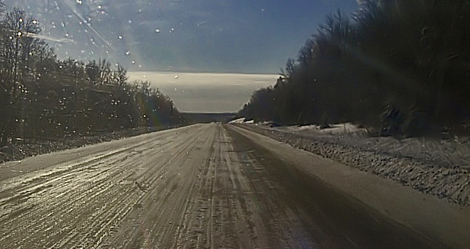
It’s that time of year again. Winter weather is upon us and Mother Nature has brought the ice and snow-covered roads back for another season.
With police already responding to numerous motor vehicle collisions related to the winter driving conditions, the Timmins Police Service is reminding drivers to “slow down, and be cautious when approaching intersections.”
“Give yourself a little extra time to reach your destination,” said OPP Constable Gillian Coughlin, of the South Porcupine detachment.
“Drive according to the road and weather conditions. Reduce your speed and increase your following distance to ensure you can stop safely if needed. Speed too fast for conditions is the most common cause of winter collisions.”
The change in road conditions brings the need for a change in driving habits, which will inevitably take some people longer to get used to than others.
“Accelerate slowly and brake sooner to avoid spin outs, especially at intersections,” said Coughlin.
Visibility is also an important factor in winter driving. Too many people don’t give themselves enough time to properly clear their vehicle of ice and snow before hitting the road.
“Ensure that you have completely brushed the snow and ice off your vehicle to allow a clear view of the roadway,” says Coughlin.
“This includes clearing your head lights and tail lights.”
Don’t forget to leave enough time for your vehicle to warm up and clear the fog from the inside of your windows as well.
The need for a properly equipped vehicle cannot be overlooked. Cold weather windshield washer fluid, quality wiper blades and snow tires are a must.
“One of the reasons you want to get snow tires, is that your conventional all season tire will start to lose traction at +7°C and 70 percent of all accidents are caused by the loss of lateral traction, which is why we see people end up in the ditch” said Brian Courville, Manager of KAL Tire on Algonquin Blvd. in Timmins.
“Snow tires are made with a softer rubber compound which remains more pliable in colder temperatures, giving you better traction and shorter stopping distances,” said Courville.
“If we take it up a notch and go with the studded tires, you can’t beat them on ice.”
The Ontario government has recently expanded the rules for using studding tires to allow the use of studded tires on vehicles registered in Northern Ontario from September 1st to May 31st.
For the purposes of the studded tire regulations, Northern Ontario is considered anywhere north of the Perry Sound and Nipissing districts.
“One of the main concerns about purchasing studded tires is the wear vs. cost,” said Courville. “A high quality studded tire will have a cushioned stud bed to allow the stud to partially retract into the tire as the vehicle is driven over dry patches of pavement as well as a reinforces stud mounting that will prevent the stud from being pulled out of the tire during use.”
Some people may try to save money by putting two winter tires on their vehicle. This is not recommended.
“80 percent of your braking and all of your steering comes out of the front wheels,” says Courville.
“That’s the reason we recommend four snow tires and not just two. Even on front wheel drive vehicles, you need to maintain traction in all four wheels to prevent loss of control.”
Despite driving cautiously and having a well prepared and maintained vehicle, there may still be an occasion when Mother Nature or a reckless driver make you spend some time in the ditch.
While the sometimes hours long wait for a tow truck can be inconvenient, it doesn’t have to be deadly.
The Government of Canada as well as organizations like the Canadian Red Cross and Timmins Porcupine Search and Rescue recommends that you carry an emergency kit in your vehicle for just such an occasion.
Your emergency kit should include some non-perishable food items such as protein bars and some bottled water.
To avoid the very likely scenario of hypothermia, make sure you’ve also brought along a blanket and at least one emergency blanket for each person in the car (They’re cheap and take up less space that a CD case).
It’s also a good idea to pack a couple of candles, an old coffee can to set them in and matches to light them with.
This will allow you to stay warm if you’re stuck without having to run your engine and risk carbon monoxide poisoning.
Glow sticks and a flash light are also recommended. While it’s a good idea to have your hazard lights turned on when you’re stuck, leaving your headlights or interior light on while you’re stuck, may cause the battery to drain past the point of being able to start your vehicle once you’ve been pulled out.
In addition to these items, it’s wise to include extra windshield washer fluid, sand or kitty litter, jumper cables, a fire extinguisher and road flares or reflective triangles in your emergency kit.
For drivers who plan to take their vehicles off road throughout the winter or anyone who wants to improve their chances of survival when things don’t go according to plan, the Timmins Porcupine Search and Rescue offers winter survival training and can be reached through their website at www.tpsar.ca.


